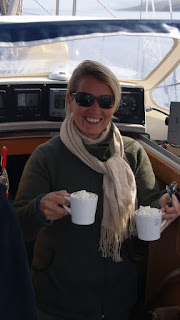Fair Isle is the most remote inhabited island in the United Kingdom. Located in Northern Scotland between the Orkneys and mainland Shetland it boasts approximately 55 permanent inhabitants. The entrance to the well protected harbor was a little precarious but we made it through and tied up to the dock. There is a bird observatory just next to the harbor and we popped in there to check if we were docked in the right location as we were the only boat in the harbor. We were told that we were welcome to join for dinner but needed to let them know early in the day.
Fair Isle is a beautiful, windswept cliffy island with sheep
clinging to the cliffs just like in the Faroer.
‘Don’t they ever fall off?’ we
asked one of the islanders. ‘Oh, yes,
all the time’ she said. ‘ Look, there’s one on the beach over there.’
We took a long walk and bumped into a father and son who had flown in in their
plane. They were staying at the South lighthouse
and managed to cadge us an invitation to dinner. Stunning vistas and friendly people at the
lighthouse.
What a wonderful balance of resourcefulness, creativity and
patience people need to have to live in this wild and beautiful place.


















































